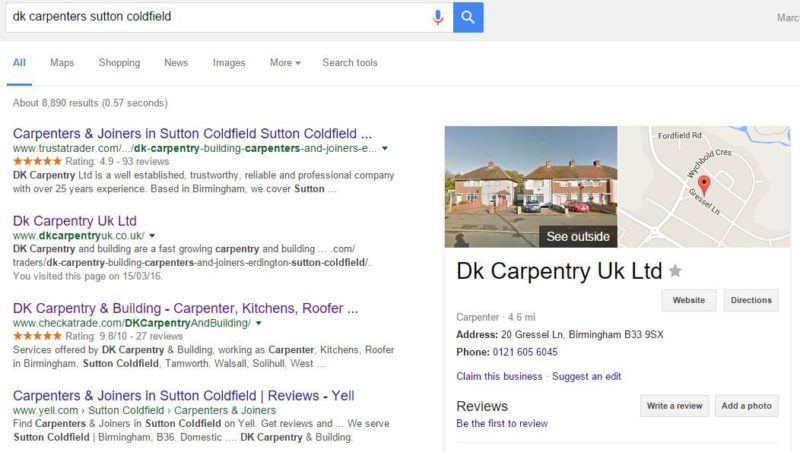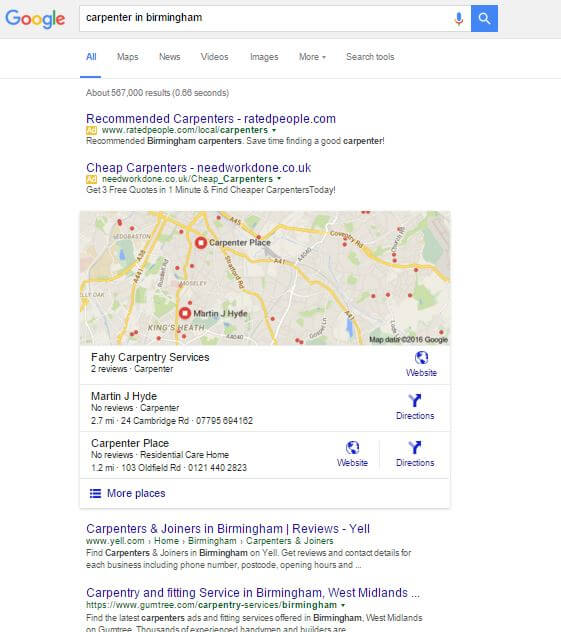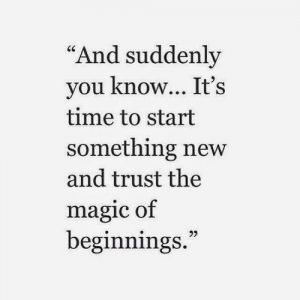Are you making the most of offline advertising to complement your local SEO efforts? Columnist Marcus Miller explains the benefits of connecting your digital and physical marketing.

It’s not easy marketing a local business in 2016. We live in a hyper-competitive environment. Petrol stations sell groceries, and grocery stores sell petrol.
For many local businesses, there is competition on every side. Specialty stores have been run out of town by supermarkets and big box stores. Many other small local businesses are being crushed by big online players. It’s tough out there.
Marketing has also changed. We exist in this new digital, mobile-driven environment. Prospects can now research purchases and service providers like never before. I can have an idea, Google it and get an answer — all in moments.
With all of this change and with all of this competition, it’s not surprising that many of those responsible for the marketing of small businesses have lost sight of basic marketing principles. We have forgotten that offline is still important. There is so much we can do offline to drive prospects to digital storefronts.
In this article, I will take a look at how the real world connects with the new digital marketing environment, and how local businesses can embrace this to get a drop on the competition.
The situation
Local businesses serve local customers — real people that exist in a given geography. Individuals with wants and needs are all around you.
One of the biggest steps you can make in your marketing journey is to realize that most people don’t even know you exist and start to address that.
Wants and needs
Let me give you a couple of examples of needs and wants:
- I need a carpenter. We are in the process of moving house, and we need some carpentry and some general painting and decorating support.
- I really want a new mountain bike. I don’t need one. Mountain biking is my hobby, and I have a perfectly serviceable, if unremarkable, entry-level bike. As I have got more into this hobby and involved in certain Facebook mountain biking groups, I have seen some truly awesome bikes, and I really, really want one.
The stimulus
This is the trigger (often an ad in some form) that drives someone to get in touch by tapping into an existing want or need. These ads can take many forms: online or offline, targeted or speculative.
Over the last week or so, I have started to pay attention to a sign attached to a fence a few hundred feet from my house for a company called DK Carpenters.
We need a carpenter. “Oh, there is that carpenter again.” You get the picture. I drove past the sign about three times before the thought cropped up at home and I thought to Google the company.
Zero Moment of Truth (ZMOT)
Last month, I took at look at the moments of truth within your marketing campaign — in particular, we looked at the Zero Moment of Truth, where a user starts to ask questions, and business can be won or lost in a micro-moment.
In a search for DK Carpenters, the results are shown below:

So we have their website, a Google+ page and a few trade directory citations with reviews. The Google+ listing could do with a bit of work, but on the whole, my ZMOT impression of this business is highly positive:
www.trustatrader.com — 4.9 stars from 93 reviews
www.checkatrade.com — 9.8/10 from 27 reviews
Diving into their website, I can see they do way more than just carpentry:
- Extensions
- Windows
- Laminate/wood flooring
- Kitchen design/kitchen fitting (supply and fit)
- Doors, skirting boards, architrave
- Garden sheds, decking, fences, summer houses
- Bespoke carpentry
- Roofing
- Wardrobes
- Plastering
- Plumbing
- Electrical
- Every aspect of carpentry and building work
This is all interesting. While the number one job we have is a bit of carpentry to box in the boiler, we also want to replace the kitchen, possibly add a summer room and do a whole host of smaller jobs throughout the house. If I can find one company that can help, and if they are local and are good at what they do, then it just makes my life a whole lot easier.
At the bottom of their home page, there is also a link to a set of reviews on a trusted portal site for businesses in the building and trade industry:
I had already seen these via my brand search, but signposting users who may have come through via an external link, direct referral or some other means is sensible and ensures that people see these strong reviews no matter the point of entry.
Alternatives
Word of mouth recommendations
I have been thinking about our renovation requirements for a few weeks now, so I mentioned it to my father, who recommended another carpenter (an acquaintance of his). He’s seen some of this guy’s work; while he is a carpenter by trade, he can also plaster and do a few other bits and bobs that would likely be useful to us.
This carpenter will be considered, as well — but in this digital age, how can I verify if he is what he says he is?
These days, it is hard to verify anyone who doesn’t have an online presence. I have a word-of-mouth recommendation from a reliable source in this case — however, I want to do my own research. Unfortunately, what should be a really solid recommendation has been let down by this person having no online presence at all.
Local searches
I could also have gone to Google and typed in locally focused searches around my micro and metro areas, such as “Carpenter in Sutton Coldfield” or “Carpenter in Birmingham.” The company mentioned above, DK Carpenters, did not appear in search results for either of these local searches.

One of their citations on www.trustatrader.com did pop up (the one with the 93 highly positive reviews), so it’s possible I could have stumbled across them indirectly via Google search.
Odds of that are amplified by the other local businesses having nothing in the way of reviews or reputation, so they have a ZMOT USP with their positive reputation that helps them stand out.
However, it’s more likely I would never have discovered them. With 15 other options on each page of results, along with a recommendation from my father, I simply would never have known this local and highly relevant business existed without that seemingly simple sign on a fence.
Reviews and reputation
Anyone who knows me knows that I am an advocate of the importance of reviews and online reputation. With so many businesses only a search away, we need a way to rate them that goes beyond the order in which they are returned by the search engine.
For a project like this, where we will be doing work on our home, reputation and the credibility of the company is critical. I am going to do everything I can to make sure I pick out businesses with a solid reputation.
This is important for most local businesses, and the benefits of good reviews on trusted portals like TripAdvisor can’t be overstated. I think the feature on TripAdvisor that shows you reviews from folks you are connected with on Facebook is genius — even if this is from someone you have not seen in several years or an acquaintance of sorts, it is still a real person that you know. This further validates the weight of that review in your ZMOT selection process.
The problem with reviews is that unless you ask, you will not receive — well, apart from the vocal minority who you upset or simply couldn’t please. A restaurant, for example, could have hundreds of happy customers each week, but if all they pick up is one bad review per month (and nothing else!), then the reputation they present is not anchored in the real world.
Likewise, for a service company like a carpenter or builder, one or two bad reviews could be enough to discount you from the selection process, and it may be wholly unrepresentative of your business and how the majority of your customers feel.
The importance of reviews and reputation can’t be overstated — being found is not enough. You must have a proactive approach to generate positive reviews from your happy customers.
Remarketing
Smart businesses will also understand that the selection process can often take days, weeks or months from a first touch to an inquiry or sale. Remarketing campaigns can be used here, as they are an effective and affordable way to stay in front of prospects during the selection process, educate them and gradually convince them you are the business to choose.
Summary
There are many ways to advertise your business that exist before a user searches that wholly complement the Local SEO and digital marketing process. Likewise, there are many ways a local customer may come across your business other than the big, obvious keywords.
Every point of contact you have with the digital and physical worlds is important:
- Physical ads — even if they are just tied to a fence!
- The sign above your shop — Include your phone number and web address.
- The sides of your van and work vehicles — Show your phone number and web address.
- Your business cards and company literature — Include social media profiles.
Smart local businesses are no longer relying on just Yellow Pages ads. Likewise, digital works well, but it should not be thought of as a complete replacement for all traditional offline advertising.
The local businesses that will win the marketing battle in 2016 and beyond will connect the dots between the physical business premises and their digital profiles. Invest and commit in this approach, and your competitors will not know what has hit them.
[Article on Search Engine Land.]
Some opinions expressed in this article may be those of a guest author and not necessarily Marketing Land. Staff authors are listed here.
(Some images used under license from Shutterstock.com.)
Marketing Land – Internet Marketing News, Strategies & Tips
(83)
Report Post





